Kagami Reflections – Japanese Antique Hand Mirrors
PRIMITIVE - Friday, February 27, 2015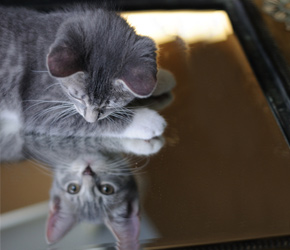 |
|
By Misaki Imagawa
What’s it like looking into a mirror for the first time? Dogs bark at their own reflection and run full speed ahead to play with the ‘newcomer,’ only to crash headlong into themselves. Cats stop, stare, and even pounce on the doppelganger. Babies smile, laugh and dance with the other little person in the mirror, even if they can’t stand up. Even as adults, when we see something unexpected in a mirror it comes as a bit of a shock – like disheveled hair in the morning. Imagine how it must have felt when early humankind caught their reflections in still pools of water for the first time. To ancient people, mirrors were full of mystique – a source of great wariness and fascination all at once.
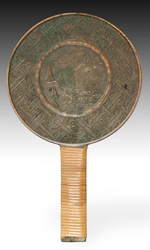 |
|
PRIMITIVE ID# A1000-174 |
In many cultures mirrors came to be associated with magic and were considered a connection to the afterworld. Some even believed souls of the dead could get trapped inside mirrors. Of course, breaking a mirror was bad luck. Some even believed that looking at your reflection with only candlelight would show you ghosts inhabiting your home. However, not all legends engender fear. In old China, it was said that mirrors would frighten away evil spirits who were, ironically, terrified of their own looks. In neighboring Japan, the mirror was associated not with spirits or ghosts, but with light, truth, and wisdom.
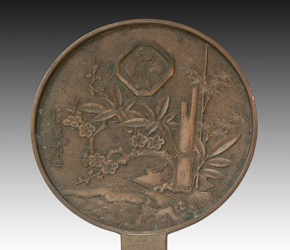 |
|
PRIMITIVE ID# A1000-173 |
The mirror was introduced into Japan from China around 300 BC. Made of polished bronze, mirrors served as utilitarian objects, but they were also highly decorated pieces of artwork. Owning a mirror was a mark of wealth and status. Several centuries after their introduction, elaborate Chinese designs appearing on the reverse side of mirrors were replaced by positive Japanese motifs of virtue and good luck. For example, Cranes were symbols of marital fidelity and bliss while turtles symbolized longevity. Pine, plum and bamboo trees were common combinations, representing strong will and perseverance owing to the plants’ tough nature of thriving during the harsh winter months. In Japan, all these symbols found their way onto the non-reflective back of hand held mirrors called kagami.
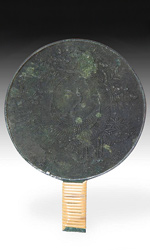 |
|
to the longevity it symbolizes; PRIMITIVE ID# A0305-181 |
There are many stories about mirrors in Japanese culture; some myth, some folklore and some historical. In mythology related to Shinto, a Japanese religion dating to the eighth century, the mirror is closely associated with the sun goddess Amaterasu. It’s said, she was startled at seeing her own face in a mirror, and that very same mirror has a name. Called Yata-no-Kagami, it is one of three “Imperial Regalia” alongside a celestial sword and curved jewel, all handed down through the line of emperors as ‘proof’ of their ‘divine’ descent. Of all the regalia, the mirror was always held in high regard because it reflected Amaterasu herself, the main deity in Shinto belief. Consequently, many shrines housed sacred mirrors in honor of the sun goddess, and in turn, they became powerful symbols of light and hope.
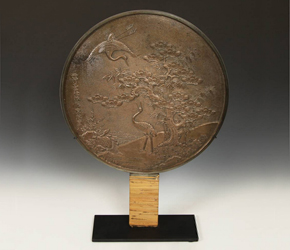 |
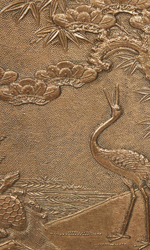 |
||
We all know the mirror is great for checking appearances, but sometimes it shows us things that may be hidden from view. In the historical book Jinno Shotoki, written by the court noble and trusted advisor to five emperors Kitabatake Chikafusa in 1339, he wrote: “The mirror hides nothing. It shines without a selfish mind. Everything good and bad, right and wrong is reflected without fail.” Many folktales pick up on this virtue and convey the message, ‘what you bring to the mirror is what you will see back.’ So bring your smile and you will be smiled upon in return. Growl and bark like a dog and it will do the same in return. Pounce on it like a cat and you are really attacking yourself. The mirror will reflect what is shown, and if you look closely enough you will see inner qualities too. Therefore, the mirror can be considered the ultimate symbol of truth and honesty.
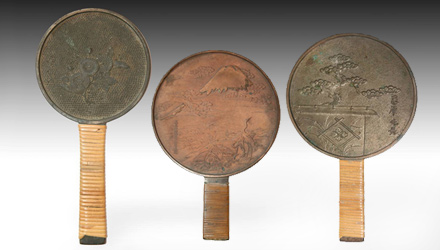 |
Download this Article: Kagami Reflections.pdf